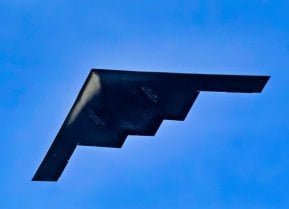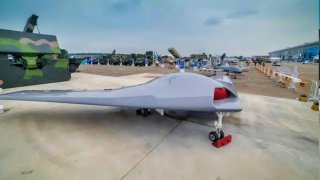China's Stealth Sky Hawk Drone Looks Like the B-2 Stealth Bomber
China has been advancing its military technology with the development of the Tianying (Sky Hawk), a stealthy unmanned aerial vehicle (UAV) or drone. Recent upgrades have enhanced its stealth characteristics and endurance, with design changes including expanded wing ailerons and new V/UHF communication antennas.
Summary: China has been advancing its military technology with the development of the Tianying (Sky Hawk), a stealthy unmanned aerial vehicle (UAV) or drone. Recent upgrades have enhanced its stealth characteristics and endurance, with design changes including expanded wing ailerons and new V/UHF communication antennas. The Sky Hawk, featuring a flying wing design similar to the U.S. B-2 Spirit, aims for high stealth and efficiency in reconnaissance and stealth strike roles. Capable of fully autonomous takeoff and landing, it's designed to operate in hostile environments, serving as a force multiplier for the People's Liberation Army Air Force by facilitating stealth penetration and precision attack missions.
China's Sky Hawk Stealth Drone: A New Era in UAV Technology
Much attention attaches to the progress of China’s aircraft carriers, anti-ship missiles, and the J-20 Mighty Dragon fifth-generation jet fighter. More stealthily, however, China has also been developing its Tianying (Sky Hawk), a tailless, low-observable, unmanned aerial vehicle.
Michael Peck wrote about the stealth drone in 2019, warning that it could become "China's terror of the skies." Writing for The National Interest, Peck noted the drone’s similarity to the flying wing design of the U.S.-made MQ-25 Stingray tanker. Yet little more was heard about the Sky Hawk until now.
Janes reported this week that the Sky Hawk has begun flight testing following upgrades to its main parameters. Citing Chinese state-owned media, Janes noted that the changes improved the UAV's stealth characteristics and its endurance.
"The upgraded UAV exhibits some design changes compared with an earlier iteration displayed during the China Air Show 2018 at Zhuhai,” Janes added. “One prominent change is an expansion of the wing aileron surfaces. The UAV also appeared to have a new antenna for very-/ultra-high-frequency (V/UHF) communications on its mid-dorsal surface.”.
Video footage of the UAV presented on China Central Television last month showed the Sky Hawk in flight with its tricycle landing gear in the wheels down position, indicative of preliminary flight testing. The Global Times shared the video of the Sky Hawk's brief flight on X.
Eyes on the Sky Hawk Drone – What We Know
The Sky Hawk has spent years in development at the No. 3 Research Institute of the China Aerospace Science and Industry Corporation (CASIC). It features a flying wing design – similar to that of the U.S. Air Force's B-2 Spirit stealth bomber – that endows it with advanced stealth capabilities.
The Chinese UAV was first revealed in 2017. It marked a significant step in the development of stealth drone technologies capable of operating in hostile environments.
The Sky Hawk is also part of a larger family of drones developed by CASIC. These include models with varied configurations and capabilities, ranging from miniature aerial vehicles to larger and more sophisticated versions.
According to Air Recognition, the initial model, the SH-1, was launched via catapult and could reach speeds of about 90 miles per hour while operating up to an altitude of 16,400 feet.
The improved SH-3, with its twin-fuselage configuration and a more limited payload capacity, illustrates the diversity and adaptability of the Sky Hawk platform. The latest version of the Sky Hawk is reported to be capable of long-endurance cruising, high stealth, aerial reconnaissance, and fully autonomous takeoff and landing without needing a catapult.
The drone is equipped for high-altitude reconnaissance missions, able to fly quickly across long distances while remaining harder for enemies to detect. Its aerodynamic design significantly reduces reflective surfaces, lowering its radar signature while enhancing its efficiency as a reconnaissance and stealth strike platform. The Sky Hawk can operate alongside manned aircraft, serving as a loyal wingman, thus expanding its versatility on the battlefield.
The assessment from Janes further suggested that the Sky Hawk could serve as a force multiplier to support the People's Liberation Army Air Force's unmanned operations, facilitating stealth penetration, precision attack, and multidimensional attack. It can be employed to conduct extensive close-in or penetrating tactical reconnaissance missions in high-threat battlefield environments, while providing comprehensive intelligence support for command decision-making and firepower strikes.
Author Experience and Expertise: Peter Suciu
Peter Suciu is a Michigan-based writer. He has contributed to more than four dozen magazines, newspapers, and websites with over 3,200 published pieces over a twenty-year career in journalism. He regularly writes about military hardware, firearms history, cybersecurity, politics, and international affairs. Peter is also a Contributing Writer for Forbes and Clearance Jobs. You can follow him on Twitter: @PeterSuciu. You can email the author: [email protected].


